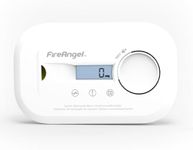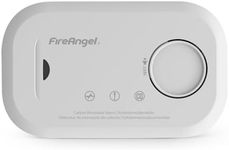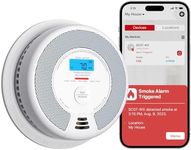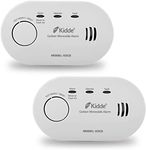Buying Guide for the Best Carbon Monoxide Detector
Choosing the right carbon monoxide detector is crucial for ensuring the safety of your home and loved ones. Carbon monoxide is a colorless, odorless gas that can be deadly, so having a reliable detector can alert you to its presence and help prevent poisoning. When selecting a carbon monoxide detector, consider the following key specifications to find the best fit for your needs.Sensor TypeThe sensor type in a carbon monoxide detector determines how it detects the gas. There are three main types: electrochemical, metal oxide semiconductor, and biomimetic. Electrochemical sensors are the most common and reliable, providing accurate readings and quick response times. Metal oxide semiconductor sensors are less common and can be less accurate, while biomimetic sensors use a gel that changes color when exposed to carbon monoxide. For most users, an electrochemical sensor is the best choice due to its reliability and accuracy.
Power SourceCarbon monoxide detectors can be powered by batteries, hardwired into your home's electrical system, or plugged into an outlet. Battery-powered detectors are easy to install and can be placed anywhere, but they require regular battery changes. Hardwired detectors are more permanent and often come with battery backups, ensuring they work even during power outages. Plug-in detectors are convenient but need to be near an outlet. Choose a power source that fits your home's setup and your preference for maintenance.
Display and AlertsA good carbon monoxide detector should have clear display and alert features. Look for detectors with digital displays that show current CO levels, as this can help you monitor any fluctuations. Audible alarms are essential, as they will alert you to dangerous CO levels even if you're asleep. Some detectors also have visual alerts, like flashing lights, which can be helpful for those with hearing impairments. Choose a detector with alert features that suit your household's needs.
InterconnectivityInterconnectivity allows multiple carbon monoxide detectors to communicate with each other. If one detector senses carbon monoxide, all interconnected detectors will sound the alarm. This feature is particularly useful in larger homes or multi-story buildings, ensuring that everyone is alerted to danger no matter where they are. If you have a larger home or want added safety, consider detectors with interconnectivity.
Lifespan and WarrantyCarbon monoxide detectors have a limited lifespan, typically between 5 to 10 years, after which they need to be replaced. Check the manufacturer's recommendations for the lifespan of the detector and look for models with a long warranty period. A longer warranty can provide peace of mind and ensure that you're covered in case of any defects. Choose a detector with a lifespan and warranty that align with your expectations for durability and reliability.
Additional FeaturesSome carbon monoxide detectors come with additional features like smoke detection, smart home integration, or mobile alerts. Smoke detection can provide added safety by combining two functions in one device. Smart home integration allows you to connect the detector to your home automation system, enabling remote monitoring and control. Mobile alerts can notify you of CO levels even when you're not at home. Consider these additional features if they align with your lifestyle and enhance your home's safety.















